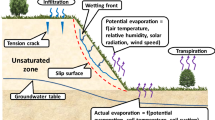Abstract
The effect of density of monofraction samples from the plow horizon of leached chernozem on the rupture rate of interaggregate bonds in water has been studied. The rupture rate of bonds has been determined in a hydraulic flume by alternating passive phases of 1–5 min in duration, during which the sample occurs under a nonmoving water layer, with short (15-s long) active phases with a water flow in the flume. Samples have also been tested for tensile strength and water infiltration rate. It has been shown that the rupture rate of interaggregate bonds is related by a hyperbolic law to the soil density and by an exponential law to the rate of water infiltration to the soil. The latter relationship varies within a year and, hence, can be used as reliable parameter for predicting the seasonal dynamics of soil erodibility.
Similar content being viewed by others
References
O. G. Bushueva, A. V. Gorobets, N. G. Dobrovol’skaya, Z. P. Kiryukhina, S. F. Krasnov, G. A. Larionov, and L. F. Litvin, “Destruction of interaggregate bonds between soil particles in the course of water erosion,” Byull. Pochv. Inst. im._V.V. Dokuchaeva., No 78, 20–30 (2015).
A. S. Voznesenskiy and A. B. Artsruni, “Physical and chemical properties of soils as a factor of surface washout,” Byull. Zakavkaz. Nauchno-Issled. Inst. Vodn. Khoz., No 12–13, 225–253 (1936).
V. B. Gusak, “Some problems of the methodology and technique of laboratory studies of soil erodibility,” Pochvovedenie., No 5, 286–295 (1950).
V. B. Gusak, “The factors and consequences of surface washout of red ferrallitic soils under conditions of humid subtropics,” in Soil Erosion (Academy of Sciences of Soviet Union, Moscow, 1937), pp. 103–154.
N. N. Konovalov and A. A. Popov, “Comparison of hydraulic conductivity of soils at different water contents,” Pochvovedenie., No 5, 104–105 (1961).
M. S. Kuznetsov, “Influence of preliminary moistening on soil loss tolerance of light chestnut soils in Yergeni as based on the study of undisturbed soil samples,” Vestn. Mosk. Univ., Ser. 6: Biol., Pochvoved., No 3, 91–99 (1967).
M. S. Kuznetsov, Soil Loss Tolerance (Moscow State Univ., Moscow, 1981) [in Russian].
G. A. Larionov, Candidate’s Dissertation in Geography (Moscow, 1973).
G. A. Larionov, “Seasonal dynamics of water permeability in dark gray and brown soils of Western Tien Shan,” in Erosion and Channel Processes (Moscow State Univ., Moscow, 1974), No. 4, pp. 110–127.
G. A. Larionov, O. G. Bushueva, N. G. Dobrovol’skaya, Z. P. Kiryukhina, S. F. Krasnov, and L. F. Litvin, “Effect of the water temperature and soil moisture on the erodibility of chernozem samples: a model experiment,” Eurasian Soil Sci. 47 (7), 734–739 (2014).
G. A. Larionov, O. G. Bushueva, N. G. Dobrovol’skaya, Z. P. Kiryukhina, L. F. Litvin, and S. F. Krasnov, “Assessing the contribution of nonhydraulic forces to the destruction of bonds between soil particles during water erosion,” Eurasian Soil Sci. 49 (5), 546–550 (2016).
G. A. Larionov, O. G. Bushueva, N. G. Dobrovol’skaya, Z. P. Kiryukhina, and L. F. Litvin, “Erodibility of model soils with different densities,” Eurasian Soil Sci. 44 (8), 914–918 (2011).
G. A. Larionov and S. F. Krasnov, “Probabilistic model of soil and cohesive ground erosion,” Eurasian Soil Sci. 33 (2), 205–211 (2000).
Ts. E. Mirtskhulava, Engineering Calculations and Prediction of Water Erosion (Kolos, Moscow, 1970) [in Russian].
S. S. Sobolev and S. I. Ponomareva, “Analysis of erosion resistance of soils,” Pochvovedenie., No 9–10, 84–85 (1945).
H. L. Cook, “The nature and controlling variables of water erosion process,” Proc. Soil Sci. Soc. Am. 15, 240–248 (1936).
D. R. Coote, C. A. Malcolm-McGovern, G. J. Wall, W. T. Dickinson, and R. P. Rudra, “Seasonal variation of erodibility indices based on shear strength and aggregate stability in some Ontario soils,” Can. J. Soil Sci. 68, 405–416 (1988).
G. E. Formanek, D. K. McCool, and R. I. Papendick, “Freeze-thaw and consolidation effect on strength of a wet silt loam,” Trans. ASAE 27 (7), 1749–1752 (1982).
G. R. Foster, “Modeling the erosion process,” in Hydrologic Modeling of Small Watersheds, Ed. by C. T. Haan, H. P. Johnson, and D. L. Brakenslek (St. Joseph, MI, 1982), No. 5, pp. 297–380.
J. H. Horton and R. H. Hawkins, “Flow path of rain from the soil surface to the water table,” Soil Sci. 100 (6), 377–383 (1965).
A. C. Imeson and M. Vis, “Seasonal variations in soil erodibility under different land-use type in Luxembourg,” J. Soil Sci. 35 (4), 323–331 (1984).
C. K. Mitchler and C. E. Carter, “Soil erodibility variation during the year,” Trans. ASAE 29 (4), 1102–1108 (1983).
M. A. Nearing, S. C. Parker, J. M. Bradford, and W. J. Elliot, “Tensile strength of thirty-three saturated repacked soils,” Soil Sci. Soc. Am. J. 55 (6), 1546–1551 (1991).
S. A. Shum and G. C. Lusby, “Seasonal variation of infiltration capacity and runoff on hillslopes in Western Colorado,” J. Geophys. Res. 68 (12), 3655–3666 (1963).
W. H. Wischmeier, C. B. Johnson, and B. V. Cross, “A soil erodibility nomograph for farmland and construction sites,” J. Soil Water Conserv. 26, 189–193 (1971).
W. H. Wischmeier and D. D. Smith, Predicting Rainfall Erosion Losses from Cropland East of the Rocky Mountains: Guide for Selection of Practices for Soil and Water Conservation, Agric. Handbook No. 282 (U.S. Department of Agriculture, Washington, 1965).
W. H. Wischmeier and D. D. Smith, Predicting Rainfall Erosion Losses—A Guide Conservation Planning, Agric. Handbook No. 537 (U.S. Department of Agriculture, Washington, 1978).
Author information
Authors and Affiliations
Corresponding author
Additional information
Original Russian Text © G.A. Larionov, N.G. Dobrovol’skaya, Z.P. Kiryukhina, S.F. Krasnov, L.F. Litvin, A.V. Gorobets, I.I. Sudnitsyn, 2017, published in Pochvovedenie, 2017, No. 3, pp. 354–359.
Rights and permissions
About this article
Cite this article
Larionov, G.A., Dobrovol’skaya, N.G., Kiryukhina, Z.P. et al. Effect of soil density, tensile strength, and water infiltration on the rupture rate of interaggregate bonds. Eurasian Soil Sc. 50, 335–340 (2017). https://doi.org/10.1134/S1064229317010094
Received:
Published:
Issue Date:
DOI: https://doi.org/10.1134/S1064229317010094




